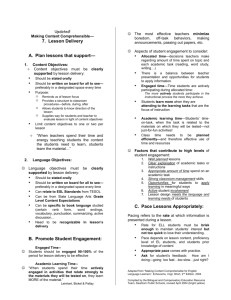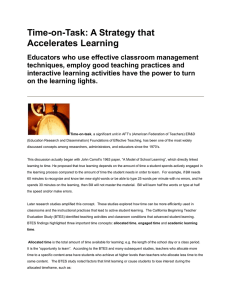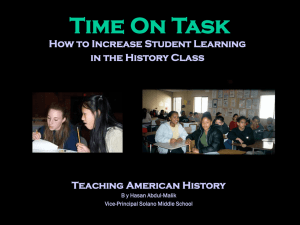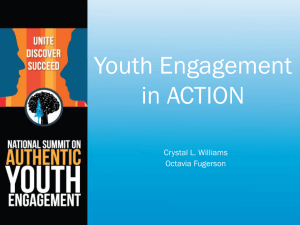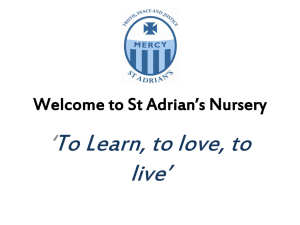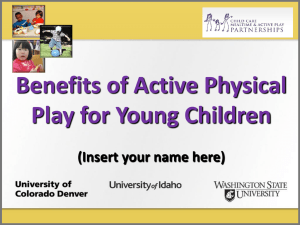SIOP-Lesson-Delivery
advertisement
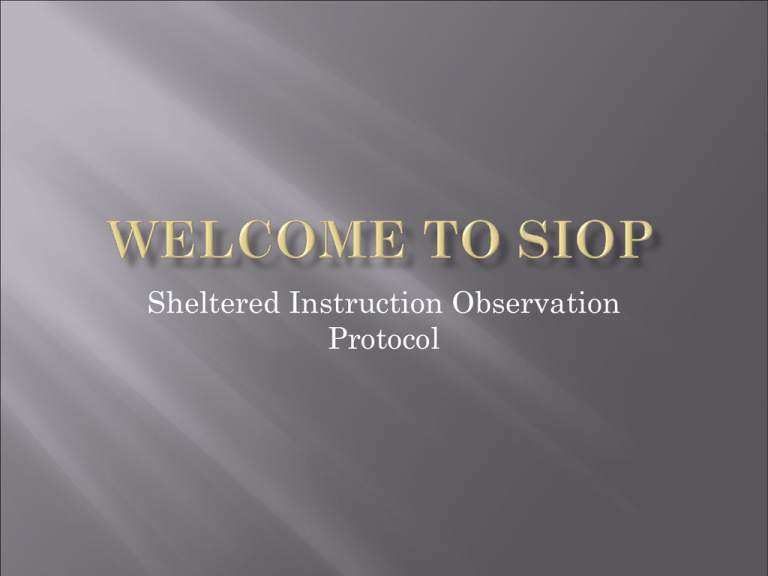
Sheltered Instruction Observation Protocol When I say go: Stand up Put your hand up in the air Find a close partner who has a different teaching assignment Give a high five Sit together Share the best part of your weekend Content You will be able to monitor a lesson to determine if delivery supports the objectives. You will be able to list strategies for improving student time-on-task throughout a lesson. Language You will evaluate and discuss the success of a lesson. You will explain what might have gone wrong and how it could be improved. •Content Objectives Clearly Supported by Lesson Delivery •Language Objectives Clearly Supported by Lesson Delivery •Students Engaged Approximately 90%-100% of the Lesson •Pacing of the Lesson Appropriate to the Students’ Ability Levels Written, student-friendly objectives: remind us of the focus of the lesson, providing a structure for classroom procedures. allow students to know the direction of the lesson. help students stay on task. Lang. Obj. may be related to an ESL strand. (Students will write to communicate with different audiences for different reasons.) Lang. Obj. may be related to teachers’ scope and sequence of language skills that their own students need to develop. (Students will make connections between text/self and text/world. Lang. Obj. must be addressed explicitly during the lesson and reviewed at the end. SIOP lessons are most effective when they include both content and language objectives. If you’re having difficulty writing objectives in student-friendly language, ask a colleague who has experience. If you’re not able to meet both objectives, evaluate whether the activities took too long or the discussion got off track. Students are engaged if they are: following the lesson. responding to teacher directions. performing activities as expected. Activities such as Think-Pair-Share and Chunk and Chew give all students the opportunity to think and speak. English learners cannot afford to have valuable class time squandered through boredom, inattention, socializing or other off-task behaviors. They also lose much needed instruction when teachers are ill-prepared, have poor classroom management skills or spend excessive amounts of time managing materials. It is essential that we minimize these behaviors and maximize time spent actively engaged in instruction. Allocated time- reflects decisions teachers make regarding the amount of time spent studying a topic and a given academic task. *Effective Sheltered Instruction teachers plan for and deliver lessons that are balanced between teacher presentation of information and opportunities for students to practice and apply the information in meaningful ways. 2. Engaged time- refers to the time students are actively participating in instruction during the time allocated. Research has consistently shown that the more actively students participate in the instructional process, the more they achieve. Instruction that is understandable, creates opportunities for students to talk about the lesson’s concepts, and that provides hands-on activities to reinforce learning grabs their attention and keeps them more actively engaged. 3. Academic learning time- focuses on student time-on-task when the task is related to materials on which students will be assessed. Creative, fun activities are not effective if they are unrelated to the content and language objectives. When you hear the tone, stand up and mix around the room. When you hear the tone again, FREEZE! Answer the question I ask you, look at the key for the corresponding number. Get into a group with that number of people. Extra students go to Lost and Found. In your group, put your heads together and make a list of strategies for improving student time-on-task throughout a lesson. (Don’t forget to include the SIOP strategies that you’ve learned!) Pacing refers to the rate at which information is presented during a lesson. Pace depends on the nature of the lesson’s content as well as the level of students’ background knowledge. It can be challenging to find a pace that doesn’t present information too quickly but is brisk enough to keep the students’ interest. *Wasting 5 minutes a day over 180 days adds up to 15 hours! Choose a number from the box. Line up in sequence. #1 chooses a table and sits down. #2 chooses, same table or different. Continue in order. Only 4 at each table. Review the 4th grade Gold Rush lesson and your individual teacher’s delivery. When you’re done, use the rubric to assess the lesson in each of the four areas. Discuss your evaluations with your group. Content You will be able to monitor a lesson to determine if delivery supports the objectives. You will be able to list strategies for improving student time-on-task throughout a lesson. Language You will evaluate and discuss the success of a lesson. You will explain what might have gone wrong and how it could be improved.
